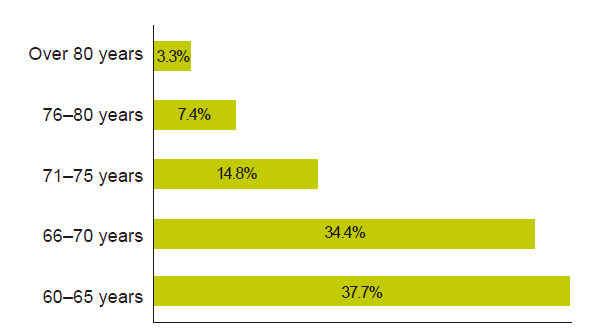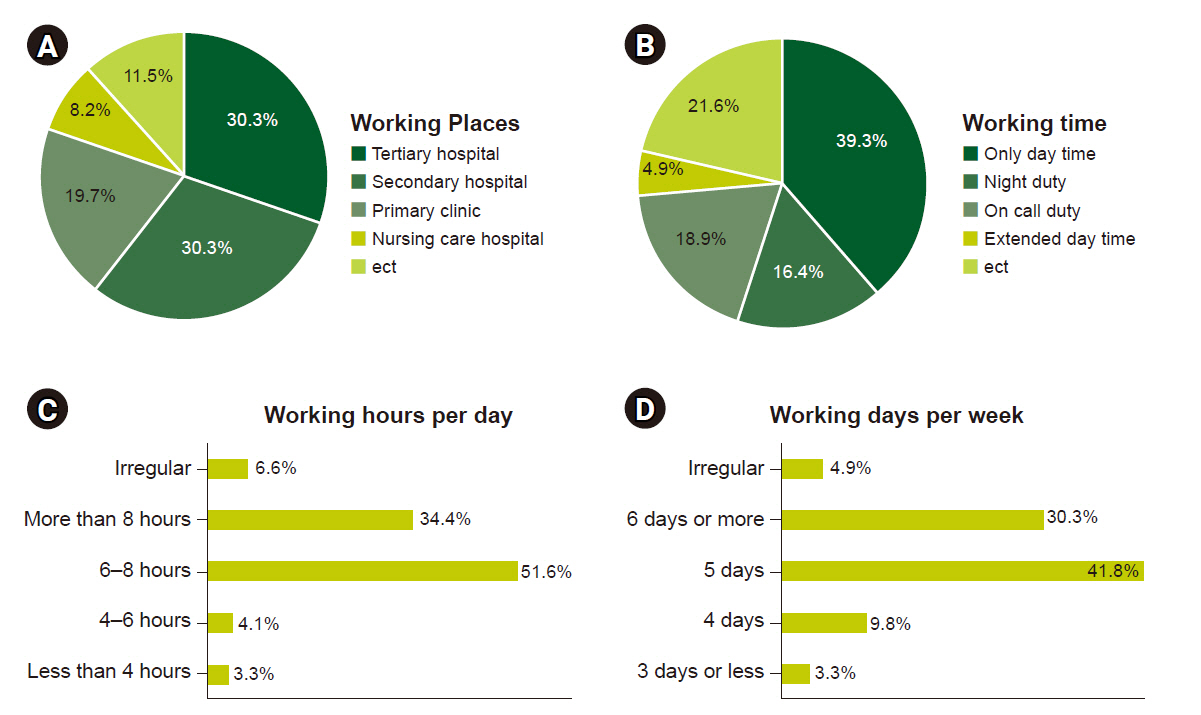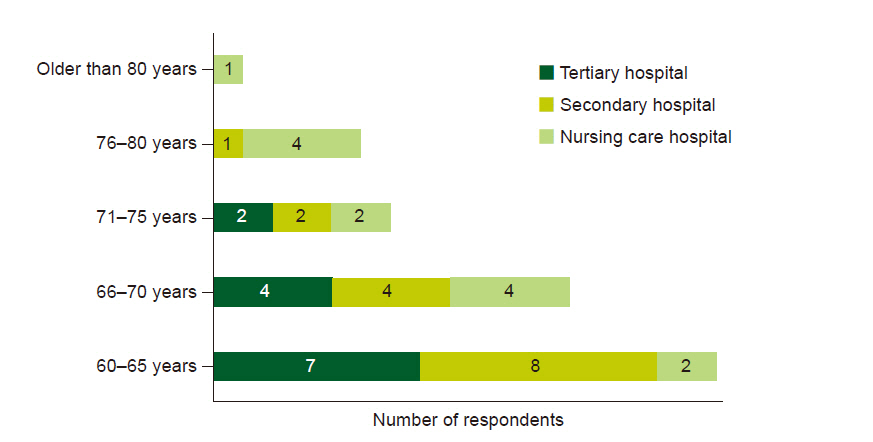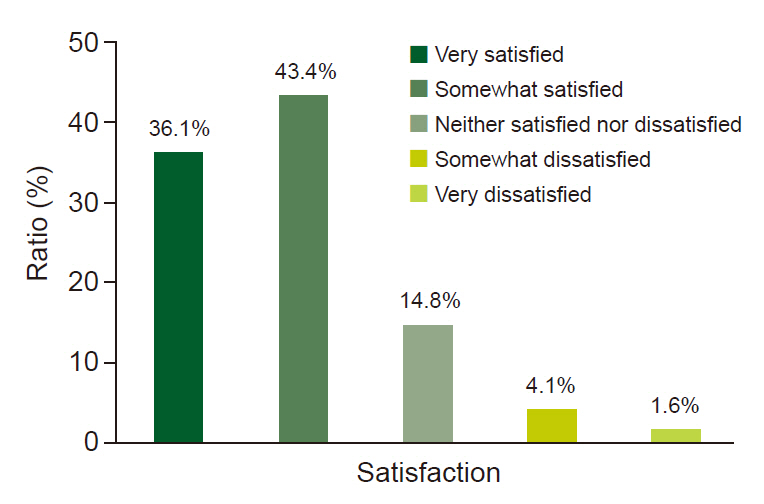Anesth Pain Med.
2021 Apr;16(2):205-212. 10.17085/apm.20071.
The senior anesthesiologists and their medical profession in Korea: based on a survey
- Affiliations
-
- 1Department of Anesthesiology and Pain Medicine, Asan Medical Center, College of Medicine, University of Ulsan, Seoul, Korea
- 2Department of Anesthesiology and Pain Medicine, Daejeon Eulji Medical Center, Medical College, Eulji University, Daejeon, Korea
- KMID: 2515549
- DOI: http://doi.org/10.17085/apm.20071
Abstract
- Background
The number of aging physicians is increasing as the global population ages. With aging, anesthesiologists would be expected to experience changes in their professional position. Therefore, we aimed to investigate the current professional status of Korean anesthesiologists aged over 60 years.
Methods
Registered anesthesiologists aged over 60 years in Korea were invited for a survey. The questionnaire addressed 10 subjects with 40 questions that focused on demographics, practical activities, work conditions, difficulties experienced due to physical changes caused by aging, and economic status.
Results
In total, 122 anesthesiologists responded to the survey (response rate: 15.7%). Of them, 30.3% were working in honorary and advisory positions at tertiary hospitals, while 19.7% were working as pain physicians. Majority of the respondents were working for 5 days a week (41.8%) and 6–8 hours/day (48.4%). Majority of them (79.5%) were generally satisfied with their present life.
Conclusions
Majority of the senior anesthesiologists were working at general hospitals and they reported being “satisfied” with the current status of their life. However, the clinical practice and retirement strategies of senior anesthesiologists need to be evaluated systematically to prepare for the continuing gradual increase in the number of senior anesthesiologists.
Keyword
Figure
Cited by 1 articles
-
A survey of anesthesiologists aged 60 years and older in Korea: current status, challenges, and future strategies
Won Uk Koh, Shamin Ara Sultana, Jong Ho Kim, So Young Lim, Sang woo Kim, Sung Mi Hwang, Youngsuk Kwon, Jae Jun Lee, Hong Seuk Yang
Anesth Pain Med. 2025;20(1):86-97. doi: 10.17085/apm.24053.
Reference
-
1. Giacalone M, Zaouter C, Mion S, Hemmerling TM. Impact of age on anaesthesiologists' competence: a narrative review. Eur J Anaesthesiol. 2016; 33:787–93.2. Mani TM, Bedwell JS, Miller LS. Age-related decrements in performance on a brief continuous performance test. Arch Clin Neuropsychol. 2005; 20:575–86.3. Baxter AD, Boet S, Reid D, Skidmore G. The aging anesthesiologist: a narrative review and suggested strategies. Can J Anaesth. 2014; 61:865–75.4. Tessler MJ, Shrier I, Steele RJ. Association between anesthesiologist age and litigation. Anesthesiology. 2012; 116:574–9.5. Katz JD. The aging anesthesiologist. Curr Opin Anaesthesiol. 2016; 29:206–11.6. Dellinger EP, Pellegrini CA, Gallagher TH. The aging physician and the medical profession: a review. JAMA Surg. 2017; 152:967–71.7. Risucci D, Geiss A, Gellman L, Pinard B, Rosser J. Surgeon-specific factors in the acquisition of laparoscopic surgical skills. Am J Surg. 2001; 181:289–93.8. Prystowsky JB. Are young surgeons competent to perform alimentary tract surgery? Arch Surg. 2005; 140:495–500; discussion 500-2.9. Baxter A, Thompson C, McCartney C. "Winding down" guidelines for anesthesiologists: the Ottawa Hospital plan. Can J Anaesth. 2016; 63:1204–6.10. Baker AB. The ageing practitioner: ANZCA's recommendations. Australas Psychiatry. 2016; 24:151–4.11. Schubert A, Eckhout GV, Ngo AL, Tremper KK, Peterson MD. Status of the anesthesia workforce in 2011: evolution during the last decade and future outlook. Anesth Analg. 2012; 115:407–27.12. Tremper KK. Anesthesiology staffing shortages – winter is coming. Decision Support Whitepaper Series [Internet]. 2019 Nov [2020 Nov 17]. Available from https://www.alertwatch.com/anesthesia-staffing-shortage-winter-is-coming/.13. Bajwa SJ, Kaur J. Risk and safety concerns in anesthesiology practice: the present perspective. Anesth Essays Res. 2012; 6:14–20.14. Gurman GM, Klein M, Weksler N. Professional stress in anesthesiology: a review. J Clin Monit Comput. 2012; 26:329–35.15. Sinha A, Singh A, Tewari A. The fatigued anesthesiologist: a threat to patient safety? J Anaesthesiol Clin Pharmacol. 2013; 29:151–9.16. Hickson GB, Peabody T, Hopkinson WJ, Reiter CE 3rd. Cognitive skills assessment for the aging orthopaedic surgeon: AOA critical issues. J Bone Joint Surg Am. 2019; 101:e7.17. The Association of Anaesthetists of Great Britain and Ireland (AAGBI). Working arrangements for consultant anaesthetists in the United Kingdom. London, AAGBI. 2011.18. Howard SK, Rosekind MR, Katz JD, Berry AJ. Fatigue in anesthesia: implications and strategies for patient and provider safety. Anesthesiology. 2002; 97:1281–94.19. Katz JD. Issues of concern for the aging anesthesiologist. Anesth Analg. 2001; 92:1487–92.20. Orkin FK, McGinnis SL, Forte GJ, Peterson MD, Schubert A, Katz JD, et al. United States anesthesiologists over 50: retirement decision making and workforce implications. Anesthesiology. 2012; 117:953–63.21. Sobal J, Ferentz KS. Comparing physicians' responses to the first and second mailings of a questionnaire. Eval Health Prof. 1989; 12:329–39.22. Hikmet N, Chen SK. An investigation into low mail survey response rates of information technology users in health care organizations. Int J Med Inform. 2003; 72:29–34.
- Full Text Links
- Actions
-
Cited
- CITED
-
- Close
- Share
- Similar articles
-
- Senior Friendly Hospital: A New Paradigm for the Hospital-based Care of the Elderly
- The state of anesthesia in South Korea: a national survey of the status of anesthetic service activity in 2014–2016
- Awareness of Students for Implementation of a Peer Mentoring Program in a Medical School
- Current supply and future workforce projections of anesthesiologists for safe anesthetic care of the Korean population
- Public awareness about the specialty of anesthesiology and the role of anesthesiologists: a national survey





